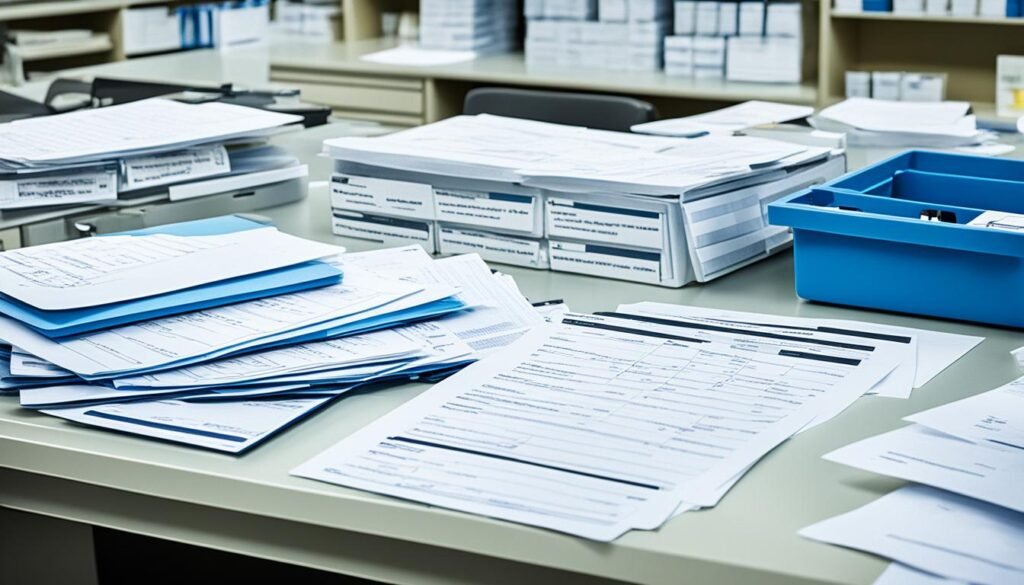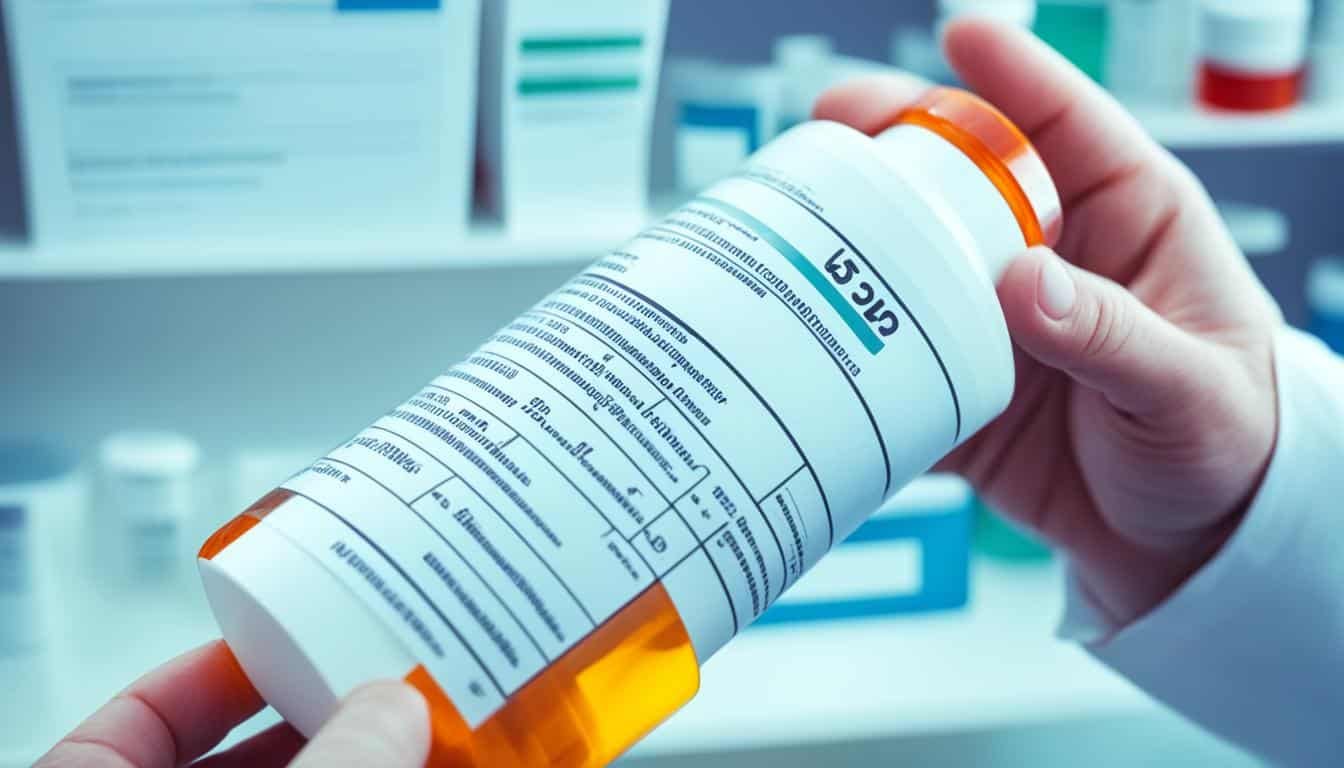A prescription is a doctor’s or other healthcare provider’s order. It tells the patient what medication or treatment they need. Once a patient gets a prescription, they can choose different ways to fill it. This includes going to a pharmacy, having the pharmacy called by the provider, or sending the prescription online. It’s important for patients to check if their health plan will pay for the medication since not all types may be covered.
Most health plans need the patient to pay a part of the prescription cost. This part is called a co-pay. Prescriptions can be filled at local pharmacies, through the mail, or online. Each way has its own good points and things to think about.
Key Takeaways
- A prescription is a healthcare provider’s order for medication or treatment
- Patients can fill prescriptions at local, mail-order, or online pharmacies
- Health plans may not cover certain types or brands of medications
- Patients often have to pay a portion of the prescription cost (co-pay)
- Pharmacists play a crucial role in verifying and filling prescriptions safely
Types of Prescriptions
There are three main types of prescriptions: paper, electronic, and verbal. Pharmacists need to treat each type differently. They must pay attention to the details and confirm they are right.
Paper Prescriptions
Healthcare providers write paper prescriptions. They give these to patients or send them to the pharmacy. Pharmacists must check these prescriptions closely. They look for any errors or signs of forgery. This checking step is crucial.
Also Read: What Are The General Admission Requirements For US Universities?
Electronic Prescriptions
Today, many providers use software for electronic prescriptions. This sends the prescription right to the chosen pharmacy. Electronic prescriptions are easier to read. They also allow for better tracking and management. With prescription software, pharmacists can quickly see all prescription details.
Also Read: What Are The Different Types Of Surgical Procedures?
Verbal Prescriptions
In emergencies, a provider may give a prescription over the phone. This is a verbal prescription. The pharmacist must write down all the details carefully. This includes the patient’s info and the medication to use. Errors can happen with verbal prescriptions, so pharmacists must be very careful.
Prescription Coverage and Costs
When you get a prescription, knowing about your prescription coverage and costs matters a lot. Most health plans have prescription benefits that can make meds not cost as much. It’s smart to check what your plan covers and what you might need to pay. This can help you understand how much you could pay for your meds.
Also Read: What Are The Top Research Universities In The US?
Insurance Coverage
Every health plan has a list of prescription drugs it will help pay for. Some drugs might not be on the list, or your insurance could ask your doctor first. Make sure to ask your insurance which drugs are part of your prescription coverage.
Co-pays and Out-of-Pocket Expenses
With many plans, you’ll pay a part of the drug’s cost, called a co-pay. How much this is can change based on your plan and if you’ve paid your deductible yet. You might also need to pay other costs, like coinsurance or your deductible. These additional costs add up and affect how much you spend on your meds.
Also Read: What Are The Ethical Considerations In Medical Diagnosis?
Prescription Savings Programs
There are ways to make buying meds cheaper. Look into prescription discounts, prescription coupons, or prescription assistance programs. These come from drug companies, non-profits, or even the government. They could lower your prescription costs, so they’re worth checking out.
Prescription Verification Process
Before a pharmacist fills a prescription, they check vital info to ensure it is safe, correct, and managed well.
Patient Information Verification
The pharmacist makes sure the patient’s personal info is correct. This includes their name, birth date, and how to contact them. They do this to make sure the medicine is right for the person and their medical info is correct.
Also Read: What Are The Key Financial Laws For Investors?
Drug Utilization Review
Then, the pharmacist looks at all the patient’s meds, health conditions, and allergies. They want to avoid any bad reactions with the new medicine. This step keeps the prescription safe and accurate.
Allergy and Interaction Checks
The pharmacist also checks the new medicine for allergies or problems with other meds. This double-check makes sure the prescription is safe and suitable for the person.
Prescription Filling Process

After verifying the prescription, the pharmacist or their tech begins the prescription filling process. They do this to make sure the medicine is right and safe for the patient.
Data Entry and Label Printing
They start by entering the patient’s and prescription details in their system. This info includes the patient’s name and the medication details. Then, a label is printed for the medicine container.
Medication Preparation
Then, they get the medicine from the stock and check it matches the prescription. They measure the correct dosage and might prepare it further if needed.
Final Verification and Dispensing
Before giving out the medicine, the pharmacist double-checks everything. They check the patient’s details and the medicine to make sure it’s all safe. If all is good, the medicine is packed safely for the patient to pick up or for delivery.
Prescription Refills
People often need prescription refills for their health. This is common for long-term treatments or chronic illnesses. Pharmacists must follow strict rules when handling prescription refills. They check the allowed refill limits and process refill requests carefully.
Authorized Refill Limits
Doctors set the number of times a prescription can be refilled. This helps keep track of a patient’s medicine use. Pharmacists watch this closely. They let patients know when their refills are low or used up.
Refill Requests and Approvals
Patients can call their pharmacy for a prescription renewal. Pharmacists check the need for more medicine. They make sure it’s safe and right for the patient. Then, they process the refill request, providing the needed medicine if everything is okay.
Prescription Errors and Safety
Pharmacists aim to get every prescription right, but mistakes happen. Prescription errors can be giving the wrong drug, the wrong amount, or missing warnings about drug interactions or allergies. Making sure prescriptions are correct is crucial. Mistakes can harm how well patients follow their prescription and their health.
Common Prescription Errors
Pharmacists need to check patient details and drug information very carefully. They should watch for things that might cause problems to avoid errors. Common mistakes include:
- Dispensing the wrong medication or strength
- Incorrect dosage or administration instructions
- Failure to identify drug interactions or contraindications
- Overlooking patient allergies or sensitivities
- Transcription errors during data entry
Prescription Safety Measures
To make prescriptions safer, pharmacists put several steps in place:
- They check patient and prescription info thoroughly
- They keep a close eye on prescriptions to catch any issues
- They talk to the doctors if something isn’t clear
- They use tools like barcode scanners and software to spot drug problems
- They train their team well in safety and accuracy
Pharmacist’s Role in Patient Safety
Pharmacists have a key job in keeping patients safe. They review each prescription closely to look for mistakes or dangers. By aiming for the best in safety and making sure patients understand their prescriptions, pharmacists protect health.
Prescription
Prescriptions are key to healthcare. They give doctors the go-ahead to use medicines correctly with their patients. This is done to make sure medicines are given out safely and work the right way by meeting special rules and advice.
Prescription Requirements
A good prescription needs the name of the patient, the type and strength of the medicine, how much to take, how to take it, how often it can be refilled, and who the doctor is with their contact and signature. These points help the pharmacy check the right person, the right medicine, and pass on how to use it correctly.
Prescription Labeling
After a prescription is filled, a prescription label goes on the medicine bottle. It shows the patient’s name, what medicine and how strong it is, how to take it, how many refills are left, and the pharmacy’s phone number. This label helps the patient know how to use the medicine right.
Prescription Administration Instructions
Besides the label, pharmacists also give detailed prescription administration instructions. They explain how, when, and how much medicine to take. They might also include if it should be taken with food or not. Clear instructions are important for the patient’s safety and to make sure they take the medicine correctly.
Prescription Delivery Options

There are a few ways patients can get their medicines. The first and most common is by going to a local pharmacy. This could be in a grocery store or its own shop. It lets people pick up their medicines close to home or work. For those who can’t go there, many local pharmacies also deliver.
Local Pharmacies
Local pharmacies, in big retail stores or by themselves, are a common choice. They are open long hours and might offer same-day or next-day pickup for urgent situations. Many local pharmcies also deliver. This means your medicine can be brought to your house or work.
Mail-Order Pharmacies
Mail-order pharmacies are great for getting your medicine delivered. They’re usually run by your insurance or a company that specializes in certain medicines. They send your medicine right to your door. This can often be cheaper than going to a store. It’s perfect for those who need to refill their medicine regularly.
Online Pharmacies
There are also online pharmacies for getting medicines. You can send in your prescription, talk to a pharmacist online, and have your medicine shipped. This can be more private and easy for people who can’t get to a store. It’s a great choice for managing your prescriptions from home.
Prescription Records and Documentation

Pharmacists keep detailed prescription records. They are for the medicines they give to patients. They make and keep a record of each patient’s patient medication profiles. This includes current and past prescription medications and refills.
Patient Medication Profiles
The patient medication profile is like a photo album of a patient’s prescription history. It helps pharmacists watch out for bad drug mixes. They also make sure the patient is getting the right amount of medicine. They’ll give advice tailored to each patient’s needs. Keeping these profiles right and current is key to using prescriptions safely and well.
Prescription Tracking and Monitoring
Pharmacists use prescription tracking and monitoring systems. These keep a complete record of all prescriptions for a patient. With these systems, pharmacists can look through a patient’s prescription history easily. They check for any problems and make sure refills or renewals are needed.
Electronic Health Records Integration
Many health providers and pharmacies now link their electronic health records. This linking makes exchanging prescription info smooth. Pharmacies can then see a patient’s full medical story. This includes prescription records. It’s very useful for catching any drug conflicts early. And, it means patients get prescription plans tailored just for them.
Also Read: Pathways To Prosperity: Building Your Success In Medical Careers
Conclusion
Filling a prescription is not simple. It needs the skills of healthcare staff, mainly pharmacists. They help patients get their medications safely and without much trouble.
The process includes many steps. This involves checking patient details, making sure drugs are safe to use, and finalizing the prescription dispensing. We also looked at why refills are important and how mistakes are avoided. Keeping detailed records is key to making sure patients are safe and follow the advice correctly.
Getting a prescription filled is teamwork. It involves doctors, pharmacists, and most importantly, the patients. By everyone working together, patients can get the best care and the right medicines to help with their health.








